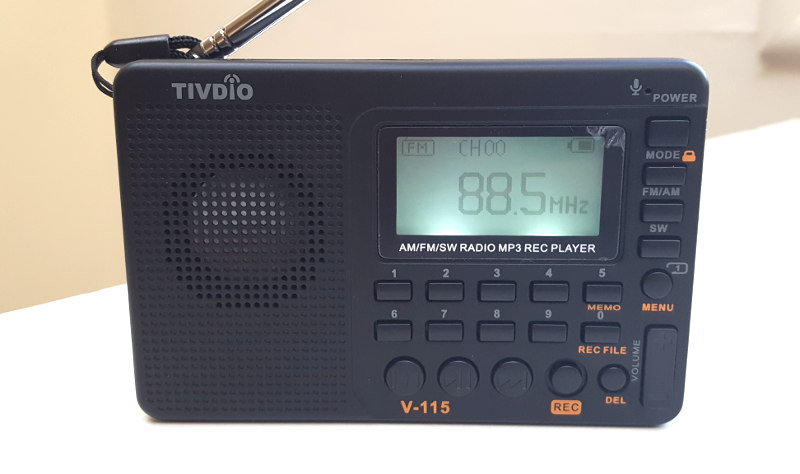
The Tivdio V-115 occupies a unique niche among DSP-based radios. First, there's the matter of branding. This radio has been sold under various names. When this review was written, at the end of 2019, this radio was better known as the Retekess V115 (no hyphen!). But it's also been sold under the Audiomax name, as well as others. It was made, or at least marketed by, the Henan Eshow Electronic Commerce Company in China. In 2019 and 2020, Henan Eshow has been using the Retekess brand name for other radios, such as the Retekess TR103.
Then's there's the matter of price. DSP-based radios typically cost at least $50 or $60 (U.S. dollars). At the end of 2019, when this review was first written, the Retekess V115 was going on Amazon for $25.
The V-115 also has an audio recorder that really works, and works well. (The recorder on the Degen DE1123 is of no practical use.) It can record at a reasonable bit rate of 128 kilobits per second in stereo, using the MP3 format, as long as a Micro SD card is inserted into the unit.
I first learned of this radio through the college radio-oriented website Radio Survivor, which especially pointed out the device's recording capabilities.
What's immediately noticeable to me, though, is the sound. The built-in speaker produces surprisingly good quality sound despite its 1" diameter. The radio actually has a miniature ported speaker system, which enhances its response at lower audio frequencies. The port in this case is in the back of the radio, labeled "Mega Bass". Well, it's not that, just because of the small size of the setup. It's not a boom box by any stretch of the imagination.
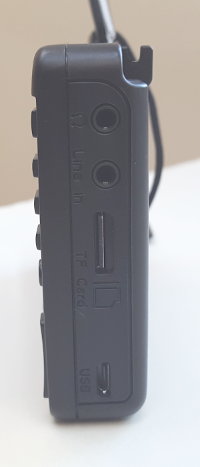
But the ported speaker makes the radio sound surprisingly pleasant and natural, especially for news or talk programming. The manufacturer seems to recognize this: there's a line-in jack (second jack from the photo at left; photo deliberately washed out so that you can see the jacks) that can be used to feed another audio source into the radio. Plugging into that jack deactivates the radio.
The headphone jack (the top jack in the photo), however, is another matter. Even with good quality headphones, the sound is tinny and out of balance: far too much treble, along with a reduced volume. There is a solution, but it may seem cumbersome.
The headphone output does seem to able to feed an amplifier just fine. So the solution is to listen to the radio using a headphone amplifier. The FiiO A1 is a common model (price at Amazon around $20) that's currently available, but my favorite is the M-Audio Bass Traveler ($37).
Using this workaround does require having an additional unit that costs as much - or more - than the radio itself. So it seems absurd. But it works.
After I first wrote this review, I found that passive headphone volume controls, such as the Koss VC20, can also be effective in restoring normal frequency balance to the audio coming out of the headphone jack. This is an inexpensive (about $10) solution that improves audio from the Tivdio's headphone jack. You may need to crank up the volume on the Tivdio when using a passive volume control. As a consequence, you may also need to turn the volume back down before unplugging from the headphone jack to avoid getting a blast of loud sound from the speaker.
The controls for the radio also can be a little offbeat. Both the numeric keypad (itself with an unusual layout) and the controls for the audio recorder are involved. You can enter the frequency of the station you want directly, but then you either have to wait a couple of seconds for the radio to tune to that channel, or press the "pause" button for the recorder. The rewind and fast-forward buttons tune in steps unless there are stations stored in memory. In that case, those two buttons tune the stations stored in memory. Up to 80 stations can be stored on FM; 60 on AM. My preference for this radio is simply not to use the memory functions at all, to preserve the ability to tune up and down the dial. There's no tuning knob or any other method to tune step-by-step.
A large vertical bar in the lower right corner of the radio is used to adjust volume up or down. The display briefly switches to a volume indicator to show the volume level. The display itself shows the frequency in large numbers.
There is a lock button, but it's bizarre: it works only when the radio is on. In other words, there's no way to lock the buttons when the radio is off to keep from accidentally turning it on. That said, the button require a very firm press in order to work, so just bumping the unit is unlikely to do anything.
The radio is far more menu-driven than most other radios I've had to this point. The recorder keys are also used to navigate through the menus once the "Menu" button (just above the volume control) is pressed.
The "FM/AM" button toggles between the two bands; shortwave reception is selected with the "SW" button, and the "Mode" button switches to the audio player. To start recording, press the "Rec" button. The manual (for radios produced since early 2018) further explains the recording function, but it's best to try several sample recordings to get the hang of how the controls work.
There's a built-in microphone, too, and the device can also record from the line-in input. There's no indication of any limitations on the capacity of the Micro SD card used for recording. I've been using 32 GB cards, which work perfectly.
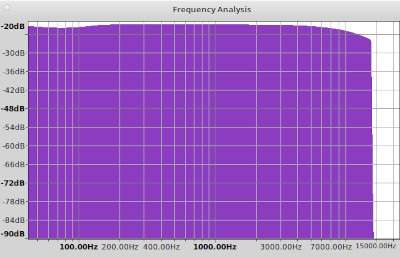
In theory, the recorder should be able to record audio up to half the sample rate. Since both the "Quality Record" and "Super Record" settings use a sample rate of 44.1 kHz, this provides a frequency response up to 22 kHz. People can't hear that entire range, of course: usually, people with good hearing don't hear much past 15 kHz. FM radio's upper boundary for frequency response is also 15 kHz.
For recording purposes, the Tivdio V-115 uses a low-pass filter that sharply cuts off all frequencies above 13.7 kHz (down to insignificance at 15 kHz; see graph at left). This is an odd value, though one that will have little impact on audio quality for a lot of people, especially when recording FM broadcasts. FM radios often have a "multiplex" filter to filter out the 19 kHz tone used for decoding stereo broadcasts, but those filters are designed to avoid affecting frequency response. When such a filter is necessary, it should cut off right at 15 kHz or a little higher. The Tivdio has a slight effect on frequency response, which isn't desirable.
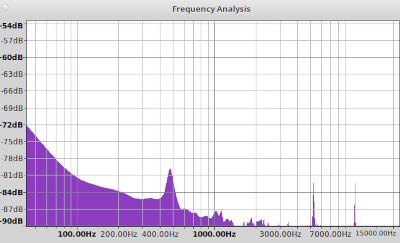
In addition, the unit generates internal noises which also appear on recordings. The graph at right shows that the noises vary by frequency and are no louder than -72 dB. Usually, the program material will mask those noises. However, they may appear in very quiet segments. For radio recording, this isn't likely to present much of a practical problem. Still, if you want to avoid these noises, you will need to use a much quieter digital recorder such as those from Tascam.
I can conclude that the Tivdio V-115 is good for convenient recording. but, between the brickwall filter and the internally generated noises that raise the noise floor, I wouldn't recommend it for recordings where quality is a top priority. The convenience of the Tivdio's recording capabilities come along with some compromises. This is when you have to remind yourself that this unit costs only $25, and even with those compromises, you're still getting a lot of capabilities for the price. However, even slightly more expensive models with recorders such as the Tecsun ICR-100 suffer from the same problems (in the case of the Tecsun, it's actually a bit worse than the Tivdio).
Dave's Radio Receiver Page has done a great job of cataloguing the numerous quirks of this radio. I won't try to cover most of that ground here. The author of that page makes an important point: some versions of the firmware used by the radio are buggy. The first truly stable firmware version seems to be 1.4. Both of my radios were purchased in 2018, and have that version.
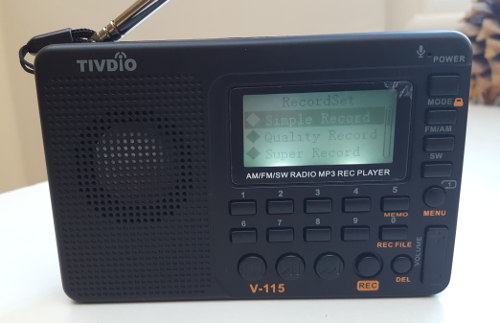
One quirk that I do want to note relates to selecting recording quality. The default is called "Quality Record", with a bit rate of 96 kilobits per second. Since MP3 encoding is used, many will feel that this produces lower-quality sound. Opinions about adequate bit rates and encoding are a highly personal matter. My own opinion is that, for an MP3 file, the minimum acceptable bit rate is 128 kilobits per second. And the V-115 can do that! But you have to go into the "RecordSet" menu and select "Super Record". And you have to do it twice. After you've done that, I advise making a test recording or two just to make sure you've managed to set the bit rate to the highest-quality setting.
Another feature that isn't well documented is the unit's shuffle, or random-playback mode. The MENU button toggles among four playback modes, which are shown by a small indicator in the upper left of the display next to the memory-card icon. When you see that indicator change from an F to an R, the radio enters a random playback mode which serves as a shuffle mode.
The other three modes appear to function identically to each other, as far as I can tell, simply stepping through the audio files sequentially. Files can also be directly accessed by number, starting with zero (i.e. the 100th file on the memory card is accessed by pressing "99" and then waiting about a second).
Holding down the PLAY button during playback provides access to a menu that includes equalization settings. Most of them are fairly subtle. The Normal setting provides a flat frequency response.
The Tivdio supports only the MP3, WAV, and WMA (Windows Media Audio) formats for audio files. It's disappointing that the Tivdio doesn't support open-source formats such as FLAC and Ogg Vorbis.
Definitely, the Tivdio's recording and playback capabilities set it apart from other DSP-based radios. Still, how does it perform as a radio?
Short answer: not so great. It's adequate for local signals, but not much more. There are also various digitally-generated noises, the sign of a poorly shielded receiver. I conducted a head-to-head comparison ("shoot-out") between the V-115 and other DSP-based radios.
It was not much competition. In the San Francisco Bay Area, a DSP-based radio gets in the range of 50 to 53 FM stations. The V-115 got 38. On AM: 38 stations for most DSP-based radios; 29 for this unit. Station counts don't tell the whole story: when the Tivdio received weaker stations, the signal didn't seem to be as strong as on the other radios, especially on FM.The rod antenna on the radio is too short for FM: just 15 inches. On AM, there's no option to restrict bandwidth to improve selectivity. Audio bandwidth on AM is 4 kHz, which, combined with the better-than-usual speaker quality, makes for pleasant AM listening. Just realize that it's not going to pull in distant signals. That said, the automatic gain control on AM seemed to work well, with good audio recovery despite variations in signal strength.
A word about the battery: the V-115 uses a BL-5C lithium-ion battery, supplied with the radio. The charging indicator is not always accurate. It's probably a good idea to keep charging it for a couple of hours after it says it's fully charged. The battery itself seems stable and holds a charge for weeks.
No doubt about it, the Tivdio (or Retekess, or ....) V-115 is one of the more interesting radios I've used, both in good ways and not-so-good ways. One way of looking at this radio's shortcomings is to ask: what do you expect for $25? I look at it a little differently: having a built-in recorder is a big plus. The Tivdio's recording and playback functions are more flexible than those of comparable products. The speaker system is also a nice touch. From that perspective, the radio becomes a supporting player rather than the star of the show.